Reckitt Benckiser Group Bundle
How Did Reckitt Benckiser Become a Global Powerhouse?
From its roots in 1840s England, Reckitt Benckiser (RB Group), now a British multinational, has evolved into a global leader in consumer goods. Its journey, marked by strategic acquisitions and innovative product development, offers a fascinating glimpse into the evolution of a Reckitt Benckiser Group SWOT Analysis. This transformation, from a simple starch mill to a company with a massive global footprint, reflects its resilience and adaptability in a competitive market.
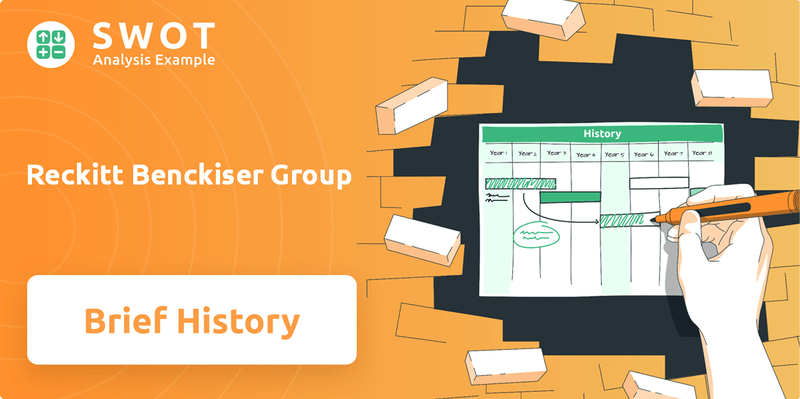
Understanding the brief history of Reckitt Benckiser provides crucial context for its current market position and future strategies. The company's financial history, including key mergers and acquisitions, helps to explain its extensive portfolio of well-known brands. Exploring the early history of Reckitt & Sons and how it transformed into the RB Group reveals the core principles that continue to drive its success in the consumer goods sector and its commitment to sustainability.
What is the Reckitt Benckiser Group Founding Story?
The story of Reckitt Benckiser, now known as RB Group, is a tale of two companies merging to create a global powerhouse in the consumer goods sector. This British multinational's history is a fascinating blend of entrepreneurial spirit and strategic acquisitions, shaping its evolution into a leading player in the industry. Understanding the Reckitt history
provides valuable insights into its current market position and future prospects.
The roots of RB Group can be traced back to the early 19th century. The journey began with two separate entities: Reckitt & Colman and Benckiser N.V. Each company, with its unique origins and product lines, contributed significantly to the eventual formation of the global corporation we know today. This company history
is a testament to the power of strategic alliances and market adaptation.
The earliest origins of what would become RB Group can be traced to Johann A. Benckiser, who founded an industrial chemicals business in Pforzheim, Germany, in 1823. Meanwhile, Isaac Reckitt established Reckitt & Sons in Hull, England, in 1840, initially focusing on Reckitt's Soluble Starch. After Isaac's death in 1862, his sons took over, with Frederick becoming the company's first chemist and George its first salesman. Benckiser saw Ludwig Reimann join in 1828, who later took ownership and expanded the chemical plant. Benckiser diversified into consumer goods, launching products like Calgon in 1956 and acquiring Finish in 1987. Reckitt & Sons expanded its product lines to include laundry blue and metal polish by 1854, going public in 1888. J. & J. Colman, founded in 1814, merged with Reckitt & Sons in 1938 to form Reckitt & Colman Ltd. The ultimate formation of Reckitt Benckiser Group plc occurred in December 1999, through the merger of British company Reckitt & Colman plc and Dutch company Benckiser N.V.
Here are some key milestones in the brief history of Reckitt Benckiser
:
- 1823: Johann A. Benckiser founds an industrial chemicals business in Germany.
- 1840: Isaac Reckitt establishes Reckitt & Sons in England.
- 1938: Reckitt & Sons merges with J. & J. Colman to form Reckitt & Colman Ltd.
- 1999: Reckitt & Colman plc and Benckiser N.V. merge to form Reckitt Benckiser Group plc.
Reckitt Benckiser Group SWOT Analysis
- Complete SWOT Breakdown
- Fully Customizable
- Editable in Excel & Word
- Professional Formatting
- Investor-Ready Format
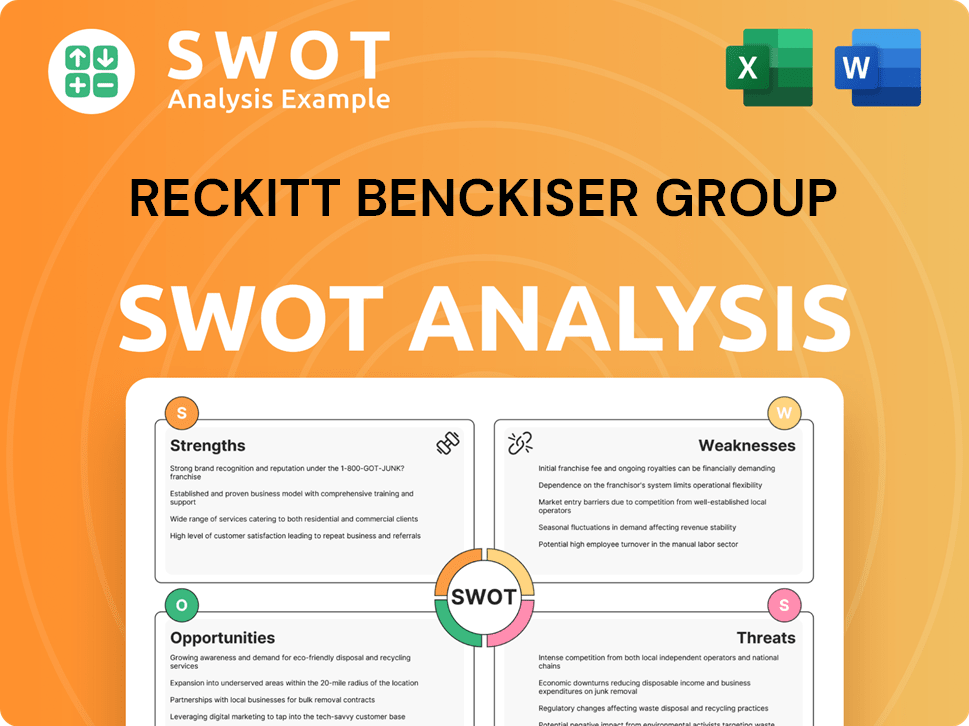
What Drove the Early Growth of Reckitt Benckiser Group?
The early growth and expansion of the company, now known as Reckitt Benckiser Group, involved significant diversification and global outreach. From its initial focus on starch, the company rapidly broadened its product range. International expansion began early, with the first overseas venture in Australia in 1886. This period was also marked by key product launches and strategic acquisitions that shaped its future.
By 1854, Reckitt & Sons had expanded its product line from starch to include a total of 22 products. These products were categorized into starch, laundry blue, metal polish, and washing paste. This rapid diversification laid the groundwork for the company's future growth and its ability to cater to a broader consumer base. The company's ability to adapt and innovate in its early years set a precedent for its future strategies.
The company's global footprint expanded significantly during this time. The first overseas business opened in Australia in 1886. Entry into South America and the USA followed in the 1900s. The initial export to a Dominion country occurred in 1864, with laundry blue sent to Montreal, Canada. By the early 20th century, Reckitt & Sons had over 5,000 staff and offices across the United Kingdom, Australia, South Africa, and the United States.
Several important product launches and acquisitions defined this period for the RB Group. Dettol, a significant pharmaceutical product, was introduced to the medical profession in 1932 and later launched to the public. In the same year, Harpic Lavatory Cleaners was acquired. The merger of Reckitt & Sons and J. & J. Colman in 1938 formed Reckitt & Colman Ltd., which further strengthened its market position.
Reckitt & Colman Ltd. continued its expansion through acquisitions. Airwick Industries was acquired in 1985, followed by the Boyle-Midway Division in 1990, which brought brands like Woolite. The Lehn & Fink division of Sterling Drug, including Lysol disinfectant, was acquired in 1994, doubling Reckitt & Colman's American business. In 1992, Benckiser acquired Coty, Inc. and went public in 1997. The merger of Reckitt & Colman and Benckiser in December 1999 formed Reckitt Benckiser Group plc, valued at £4.9 billion ($7.7 billion) at the time. The combined entity had annual revenue of £3.12 billion in 1998.
Reckitt Benckiser Group PESTLE Analysis
- Covers All 6 PESTLE Categories
- No Research Needed – Save Hours of Work
- Built by Experts, Trusted by Consultants
- Instant Download, Ready to Use
- 100% Editable, Fully Customizable
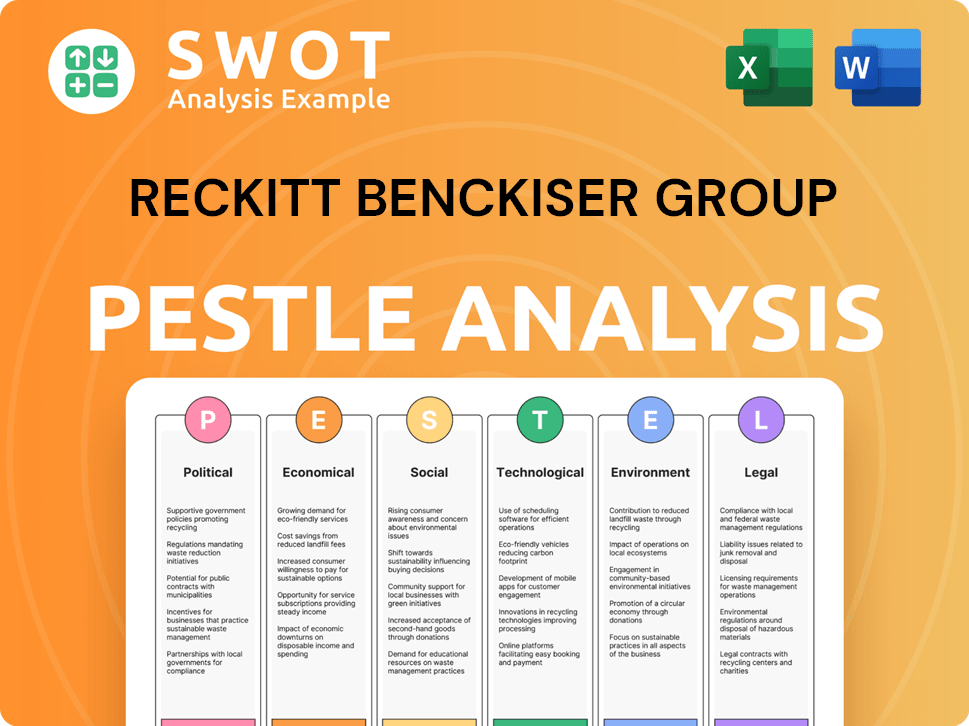
What are the key Milestones in Reckitt Benckiser Group history?
The Reckitt Benckiser (RB Group) has a rich
Company history
marked by significant milestones that have shaped its evolution into a global leader in consumer goods. The 1999 merger of Reckitt & Colman plc and Benckiser N.V. was a pivotal event, creating the multinational corporation known today.| Year | Milestone |
|---|---|
| 1999 | Merger of Reckitt & Colman plc and Benckiser N.V., forming the modern RB Group. |
| 2006 | Acquisition of Boots Healthcare International, adding brands like Nurofen and Strepsils. |
| 2010 | Acquisition of Durex, expanding its portfolio with a major global brand. |
| 2012 | Acquisition of Schiff Nutrition, entering the vitamins and supplements market. |
| 2017 | Acquisition of Mead Johnson Nutrition for approximately $16.6 billion, broadening its infant nutrition footprint. |
Innovation has been a cornerstone of the RB Group's strategy, with the company consistently introducing new products and expanding its market reach. The launch of Disprin in 1960, and the acquisitions of brands like Airwick and Veet, demonstrate its commitment to developing and acquiring innovative products.
In 1960, the company launched Disprin, the first soluble aspirin, marking an early innovation in healthcare.
RB Group entered the air freshener market through acquisitions, starting with Haze and Floret in 1960, and later Airwick Industries in 1985.
The acquisition of Gaviscon in 1970 further expanded the company's presence in the healthcare sector.
Veet became a RB Group brand in 1969, adding to its portfolio of personal care products.
In 2010, RB Group gained major global brands including Durex through an acquisition, expanding its consumer health offerings.
In 2012, the company acquired Schiff Nutrition, a manufacturer of vitamins and nutritional supplements, for US$1.4 billion.
The RB Group has faced various challenges, including market downturns and competitive pressures, which have impacted its financial performance. In fiscal year 2024, the company reported a decrease in profit and revenue, though it is taking strategic steps to address these issues.
The company has experienced market downturns and competitive threats, impacting its overall financial performance.
In fiscal year 2024, profit before income tax fell to £2.10 billion from £2.40 billion, and net revenue dropped 3% to £14.17 billion.
The Nutrition segment saw a 7.3% decline in sales in 2024, partly due to the impact of the Mount Vernon tornado on supply chains.
RB Group is focusing on its 'Powerbrands,' which accounted for 71% of its revenue in 2024, and is on track to exit its Essential Home business by the end of 2025.
The company aims to become a more efficient, world-class consumer health and hygiene company.
RB Group is evaluating opportunities for its Mead Johnson Nutrition business as part of its strategic adjustments.
Reckitt Benckiser Group Business Model Canvas
- Complete 9-Block Business Model Canvas
- Effortlessly Communicate Your Business Strategy
- Investor-Ready BMC Format
- 100% Editable and Customizable
- Clear and Structured Layout
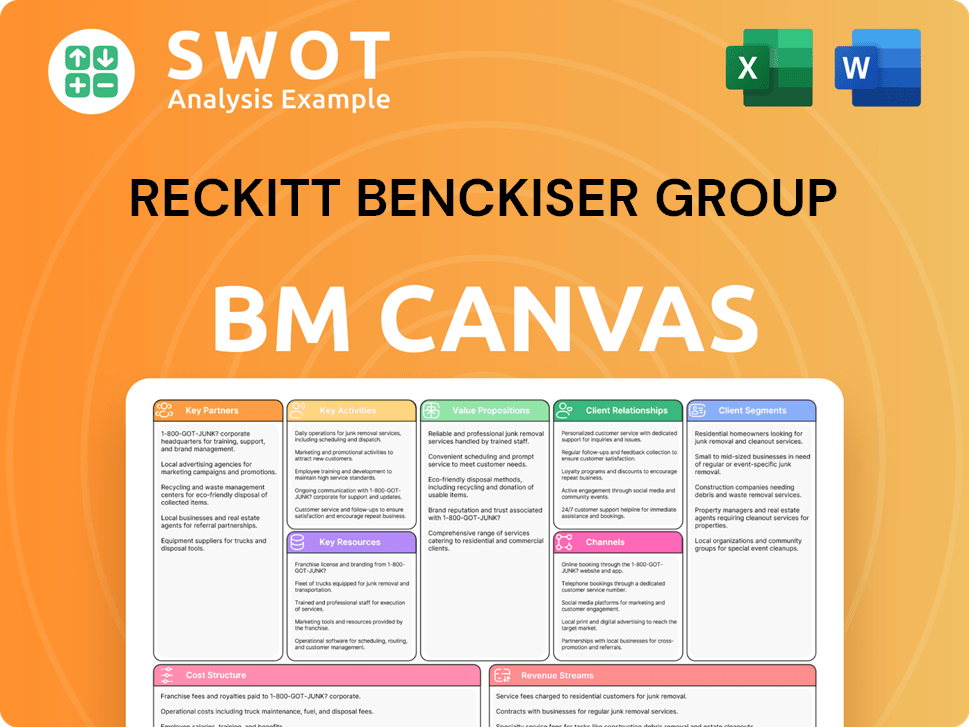
What is the Timeline of Key Events for Reckitt Benckiser Group?
The Reckitt Benckiser (RB Group) history is a story of growth through strategic mergers, acquisitions, and product innovation. From its origins in the 19th century, the company has evolved into a global leader in consumer health, hygiene, and nutrition. The journey showcases a commitment to adapting to market changes and expanding its portfolio to meet evolving consumer needs, solidifying its position in the consumer goods sector.
| Year | Key Event |
|---|---|
| 1814 | Jeremiah Colman starts milling flour and mustard in Norwich, UK. |
| 1823 | Johann A. Benckiser founds an industrial chemicals business in Pforzheim, Germany. |
| 1840 | Isaac Reckitt establishes Reckitt & Sons in Hull, England, focusing on starch production. |
| 1888 | Reckitt & Sons is first listed on the London Stock Exchange. |
| 1932 | Dettol, an antiseptic, is launched, and Harpic Lavatory Cleaners is acquired. |
| 1938 | Reckitt & Sons merges with J. & J. Colman to form Reckitt & Colman Ltd. |
| 1985 | Reckitt & Colman acquires Airwick Industries, strengthening its aircare portfolio. |
| 1994 | Lysol becomes a Reckitt & Colman brand after the acquisition of L & F Products. |
| 1999 | Reckitt & Colman plc merges with Benckiser N.V. to form Reckitt Benckiser plc. |
| 2006 | Reckitt Benckiser acquires Boots Healthcare International, adding brands like Nurofen and Strepsils. |
| 2010 | Reckitt Benckiser gains major global brands, including Durex. |
| 2012 | Acquisition of Schiff Nutrition for US$1.4 billion. |
| 2014 | Reckitt Benckiser drops its full name in favor of the 'RB' brand. |
| 2017 | Mead Johnson Nutrition joins RB, significantly expanding its infant nutrition segment. |
| 2021 | The company officially rebrands as Reckitt. |
Reckitt maintains its full-year 2025 guidance, anticipating a 2-4% like-for-like net revenue growth for the group. The company projects mid-to-high single-digit growth in emerging markets for Q2 2025. Europe is expected to see low-single-digit growth, while North America may experience a low-single-digit decline.
Reckitt is focusing on its 'Core Reckitt' segment, which includes 11 'Powerbrands' such as Mucinex, Strepsils, Lysol, Dettol, and Durex. The aim is to achieve a 3-4% like-for-like net revenue growth in this area in 2025. From 2026, Core Reckitt is projected to deliver consistent 4-5% like-for-like net revenue growth.
The company plans to exit its Essential Home business by the end of 2025. Reckitt continues to evaluate opportunities for its Mead Johnson Nutrition business, reflecting an ongoing portfolio optimization strategy. This strategic focus aims to streamline operations and enhance profitability.
Reckitt is committed to innovation, sustainability, and digital transformation. These initiatives, combined with a focus on high-growth categories, position the company for continued relevance in the global consumer health and hygiene market. This approach reflects the company's dedication to improving well-being, echoing its founding vision.
Reckitt Benckiser Group Porter's Five Forces Analysis
- Covers All 5 Competitive Forces in Detail
- Structured for Consultants, Students, and Founders
- 100% Editable in Microsoft Word & Excel
- Instant Digital Download – Use Immediately
- Compatible with Mac & PC – Fully Unlocked
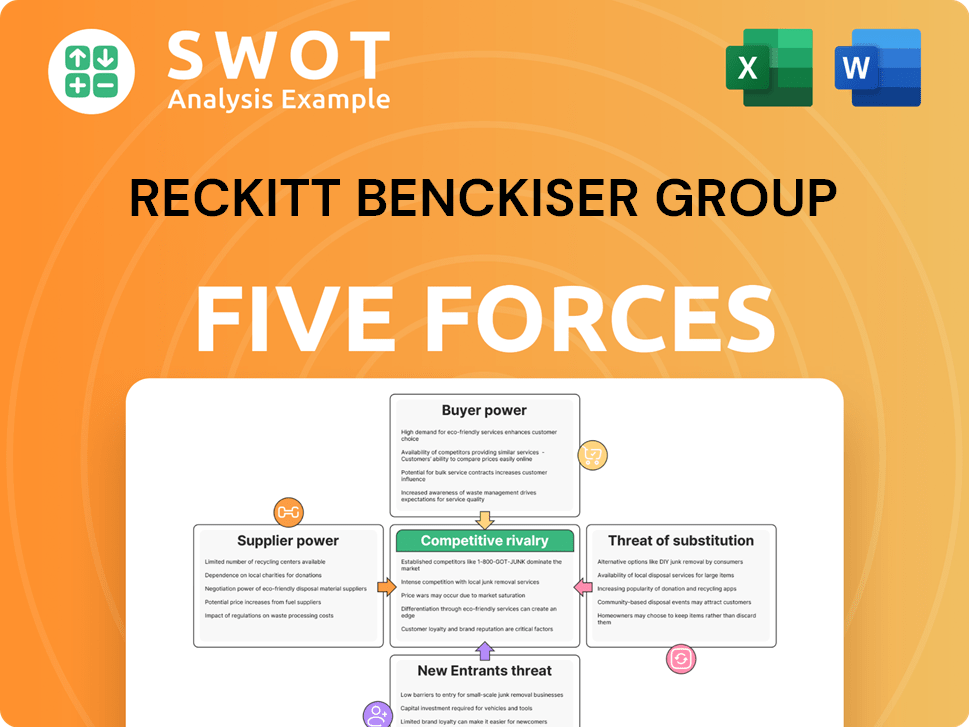
Related Blogs
- What is Competitive Landscape of Reckitt Benckiser Group Company?
- What is Growth Strategy and Future Prospects of Reckitt Benckiser Group Company?
- How Does Reckitt Benckiser Group Company Work?
- What is Sales and Marketing Strategy of Reckitt Benckiser Group Company?
- What is Brief History of Reckitt Benckiser Group Company?
- Who Owns Reckitt Benckiser Group Company?
- What is Customer Demographics and Target Market of Reckitt Benckiser Group Company?
Disclaimer
All information, articles, and product details provided on this website are for general informational and educational purposes only. We do not claim any ownership over, nor do we intend to infringe upon, any trademarks, copyrights, logos, brand names, or other intellectual property mentioned or depicted on this site. Such intellectual property remains the property of its respective owners, and any references here are made solely for identification or informational purposes, without implying any affiliation, endorsement, or partnership.
We make no representations or warranties, express or implied, regarding the accuracy, completeness, or suitability of any content or products presented. Nothing on this website should be construed as legal, tax, investment, financial, medical, or other professional advice. In addition, no part of this site—including articles or product references—constitutes a solicitation, recommendation, endorsement, advertisement, or offer to buy or sell any securities, franchises, or other financial instruments, particularly in jurisdictions where such activity would be unlawful.
All content is of a general nature and may not address the specific circumstances of any individual or entity. It is not a substitute for professional advice or services. Any actions you take based on the information provided here are strictly at your own risk. You accept full responsibility for any decisions or outcomes arising from your use of this website and agree to release us from any liability in connection with your use of, or reliance upon, the content or products found herein.